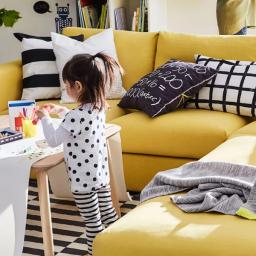Ikea: from match seller to furniture giant
When I say IKEA, what do you think of? I immediately imagine their big blue and yellow building, where it's always busy and where you can eat Swedish balls after spending hours looking for furniture with usually unpronounceable names. What preceded this global success?

Agunnaryd
The IKEA story begins in a small village in Sweden, Agunnaryd. There lived a boy, Ingvar Kamprad. Ingvar started his career at the age of five, selling matches to nearby farms. This was to supplement the meager family income of his poor farming family, but he may have already noticed that he was better at selling than he was at learning at school. At 17 and with his diploma in hand, he founded Ikea in 1943, during World War II. Initially, it was a mail-order company selling everything and anything. Kamprad cycled between the post office and his house to sell pens, pencils, tights and wallets. The name Ikea was an acronym based on the initials of his first (Ingvar) and last name (Kamprad), the name of the family farm (Elmtaryd) and his village (Agunnaryd). It was a humble beginning. What really put IKEA on the map was furniture. In 1948, Ingvar started offering furniture in his mail-order catalogue. It turned out to be a great success.
The ‘flatpack’ revolution
Let’s fast forward to 1956, which turns out to be a pivotal year in Ingvar’s entrepreneurial journey. The story goes that one of his employees, Gillis Lundgren, was struggling to get a table into his car on his way to a photo shoot for the catalogue. Then Gillis had the idea: why not take the legs off so that the table could fit flat in the car? What started as a practical solution to a logistical problem grew into the core strategy that drastically reduced production costs and enabled global distribution. A great lesson in how such a small adjustment can make a world of difference, right?
Innovative mindset
After the introduction of flatpack furniture, IKEA grew. More and more department stores opened in Sweden, followed by Europe and the world. What made IKEA unique was not only the affordable price and the flat packaging, but also the innovative mindset that Ingvar built into the entire company culture. A good example of this is the IKEA concept of self-service. Instead of a traditional furniture store, where salespeople guide the customer through a showroom, he created an experience where customers can choose their own furniture, pick it up from the warehouse and then assemble it at home. This ‘do-it-yourself’ model not only reduced costs for the company, but also created a unique shopping experience and customer connection. IKEA understood that customers were not just looking for a product, but also for a sense of accomplishment. You felt proud when you built something yourself!
IKEA language
Something that really sets IKEA apart (as I mentioned in the introduction) is the unique naming of their products. It is more than just a marketing thing. The names, sometimes really unpronounceable, contribute to the character and recognizability of the brand. Where other companies often use numbers or generic names, IKEA gives its products unique, often Scandinavian names. This creative naming is far from random. For example, bathroom accessories are named after Scandinavian lakes and rivers. This system, devised by Ingvar Kamprad himself, was introduced so that customers would not be confused by some complicated number system. But it wasn’t just the customers who benefited. Ingvar was dyslexic and these names helped him to remember and categorize the products more easily. Funny, isn’t it? It reminds me of Berthold Gunster’s concept of ‘rethinking’. You have a problem and you think about it as an opportunity. The system also seems to give customers a sense of authenticity. It makes it more personal, as if you were bringing a friend into your home instead of a chair.
Overview of IKEA names and their derivatives:
- Beds, wardrobes and wardrobe items: Norwegian place names
- Dining tables and chairs: Finnish place names
- Furniture and handles: Swedish place names
- Garden items: Swedish islands
- Bookcases: professions
- Bathroom items: Scandinavian rivers and lakes
- Lighting: Swedish terms in music, chemistry, meteorology, seasons, months, days, measures, weights, boats and nautical language
- Chairs and desks: boys' names
- Fabrics and curtains: girls' names
- Curtain accessories: mathematical and geometric concepts
- Linen and cushions: flowers, planets, jewellery
- Children's items: mammals, birds, adjectives
- Boxes, posters, maps, frames, clocks: Swedish place names, expressions

Dark Sides
Although IKEA has been hugely successful, the company has also faced serious criticism, particularly in the areas of working conditions and sustainability. In the 1990s, there was a growing awareness of the impact of deforestation and the ecological footprint of large companies. IKEA was criticized for its use of wood and other raw materials. Since then, the company has tried to become more sustainable, but criticism of the environmental impact of their mass production continues to this day. Especially because the low prices and constant flow of new products mean that people replace their furniture more often and waste increases. IKEA has also been criticized for the poor working conditions at their suppliers in low-wage countries, such as China, India and Vietnam. During this period, there were also reports of child labor. IKEA has since made efforts to improve working conditions, but concerns about compliance with labor rights in some cases remain.
Ingvar Kamprad himself has also been criticized. In the 1990s, newspapers revealed that he had been a member of the fascist movement in Sweden until the 1950s. He recruited members, raised money and showed up at meetings. A letter from 1950, in which he wrote to the leader that he was ‘proud’ of his involvement, caused a media frenzy that would haunt him forever. ‘The biggest mistake of my life. A part of my life that I bitterly regret’, he said about it time and again. Kamprad was also heavily criticized because he lived in Switzerland as a multimillionaire and did not pay a cent in taxes in Sweden. It was only after the death of his second wife that Kamprad moved back to Sweden. The tax bill that followed, more than half a million euros.
Learning from mistakes
IKEA clearly shows that it learns from its mistakes. For example, IKEA increasingly uses recycled wood, plastic and other materials. In addition, they have promised to be fully circular by 2030. From then on, all products will be designed with reuse in mind. IKEA also invests in renewable energy. Most stores have solar panels and IKEA has its own wind and solar parks. In addition, they have started take-back programs where customers can bring back old furniture. These are then repaired or recycled. IKEA is also working to improve working conditions in its supply chain. The company has introduced an “IWAY” code, which provides strict guidelines for suppliers regarding working conditions, environmental impact and social responsibility. IKEA works with external auditors to ensure that all suppliers meet these standards. IKEA also works with independent organizations such as UNICEF and Save the Children to combat child labor in high-risk areas. And while this remains a controversial topic, with Ingvar Kamprad repeatedly expressing regret for his ties to fascism, IKEA has managed to build a culture that embraces diversity and inclusion over the years. In addition to their recruitment policies and training in this area, you can see that IKEA supports the LGBTQ+ community through inclusive marketing campaigns and by participating in events such as Pride. They also have products in their range that promote gender neutrality and/or suit different lifestyles, traditions and backgrounds. IKEA more than just a furniture giant
IKEA is a brand that is deeply rooted in the history and culture of Sweden. Nevertheless, like other large multinationals, they will continue to be part of discussions around working conditions and sustainability for the time being. Success is not just about growth and profit, but also about making responsible choices.
Finally
Kamprad passed away on January 27, 2018 in a small Swedish village, Småland. Just a ten-minute drive, on the other side of the lake, from the farm where he was born 91 years ago.
Sources: NOS, De Groene Amsterdammer, HighNames
Related articles
The road to success is often erratic with unexpected turns, blunders and lessons. That's what makes it interesting and inspiring, too. Take the story of Ben & Jerry's, the famous ice cream brand.
Coolblue's' journey 'is one to enjoy! really another inspiring entrepreneurial story that starts with a couple of friends in a dorm room. Read more and get inspired!
The story behind Starbucks. Discover the entrepreneurial story behind this special company and be inspired.
Start closing more deals with smarter proposals
Try Offorte free for 14 days - no credit card needed
